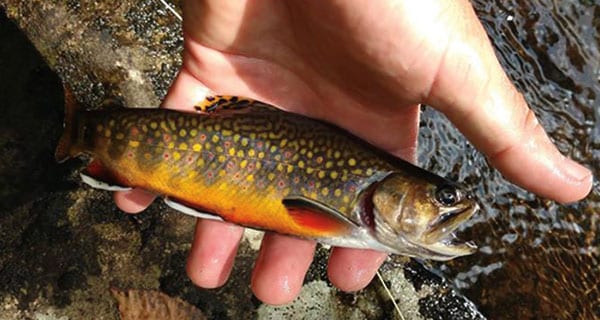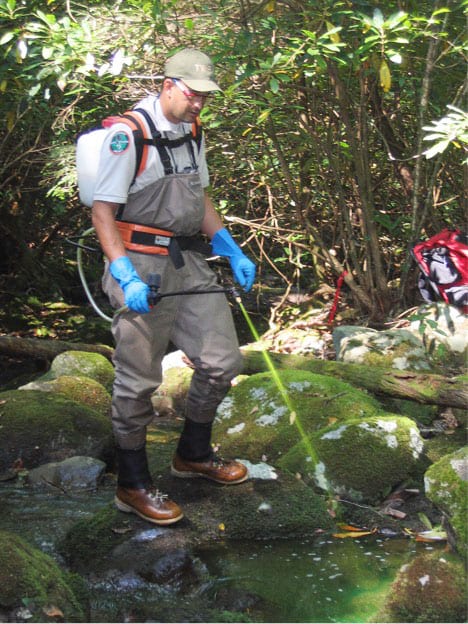
National Park Fisheries Department
Once upon a time, the Brook Trout (Salvelinus fontinalis) was abundant and widely distributed within eastern North America. These fish thrived in the cold, clean streams where they reigned as the only native salmonid in Appalachia. These incredible fish were perfectly adept for life in these waters… until the very waters they were built to survive in began to change.
As timber companies and settlers changed the land around them by logging and farming, the loose soil once held by roots was washed into the streams, and the cool waters, once shaded by the trees, became hot without the dense canopy to protect them. In addition, logging companies and the National Park Service (NPS) stocked over 1.4 million non-native rainbow trout into park streams, which outcompeted and further displaced native Brook Trout populations. Since the 1900’s, the Brook Trout, which were once abundant, declined by 75% in Great Smoky Mountain National Park (GRSM) due to logging practices performed before the creation of the park in 1936.
Even as the land began to heal from these transgressions, the sky above became polluted from the gasses released from factories, cars, and power plants. The rain that once brought relief to the drying earth below, now brought an assault of acid that altered the chemistry of the soil and the streams.

The NPS sought to restore the Brook Trout, not just because they are native to the local streams and rivers where they have dwelled for millennia, but because these fish are intertwined with southern Appalachian heritage. These Brook Trout are the descendants of those who saw the first European settlers arrive in Tennessee, the same lineage as those who supported Native American settlements for centuries, and of the same blood as those who knew these waters when they were fed by the glaciers covering North America.
In 2016, the NPS began efforts to restore Anthony Creek by dividing the stream above a barrier mill dam into 34, 100 meter sections and removing non–native rainbow trout using the 3-Pass Depletion method and backpack electrofishing units.
Backpack electrofishing units send 600-700 volts of electricity into the water, which stuns the fish, and allows backup netters to net and capture the non-native Rainbow Trout. Each section is worked through three times to ensure a high capture rate.
Using this method, 2,284 Rainbow Trout, or 99.3 percent of the trout population, were removed in 2016.

In 2018, the NPS continued reintroduction efforts by capturing approximately 230 Brook Trout from Deep Creek and Sahlee Creek within the Deep Creek watershed (also a genetically pure Little Tennessee tributary). With the help of our friends from the NPS trails crew and their trusty mules, the fisheries crew were able to haul the trout safely up the mountain trail, and from there transport them to Anthony Creek. If all goes as planned, these new recruits will disperse, multiply and reach carrying capacity within 3 years.
The restoration of Little Cataloochee Creek began in 2017. This restoration utilized a different method to remove Rainbow Trout due to the larger size of the stream, which includes many holes deeper than 3-4 feet deep, complex habitat and wider stream sections. Instead of backpack electrofishing, the EPA approved piscicide Antimycin A, which was utilized to remove Rainbow Trout from a 3 mile section of stream. Antimycin A acts by inhibiting cellular respiration of fish, including Rainbow Trout. One 8-hour treatment of Antimycin A depleted all Rainbow Trout within the restored section of Little Cataloochee Creek. Below the barrier waterfall at the lower end of the treatment zone, the antimycin was neutralized using potassium permanganate; once neutralized, the antimycin becomes ineffective and no fish are killed downstream of the barrier falls.

In 2018, the stream was monitored to evaluate the condition of the reintroduced Brook Trout. An additional 151 Brook Trout were captured from Correll Branch and transported to Little Cataloochee Creek to augment the existing population. The 2018 Brook Trout population surveys indicate Little Cataloochee Creek is recovering very nicely and should be back to carrying capacity within three years.
The successful restoration of Little Cataloochee Creek brings the total number of Brook Trout streams restored within GRSM to 13 and includes 30.5 miles of stream habitat.
The GRSM Fisheries Department conducts several Brook Trout restoration projects, as well as dozens of water quality monitoring activities with the help of Park Fisheries employees, seasonal staff, interns and large numbers of volunteers from western North Carolina, eastern Tennessee, western South Carolina and north Georgia.
If you or someone you know would like to volunteer with the Great Smoky Mountains National Park Fisheries Department, please contact: North Carolina Volunteer Coordinator for the NC side of the Park, Mike Kesselring (828) 736-6929, mikesseL59@gmail.com, or Tennessee Volunteer Coordinator for TN side of the Park, Richard Barnes (949) 212-8480, canceleer1@gmail.com.